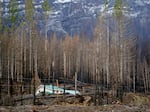After a failed rollout of a state wildfire risk map last year, Oregon researchers and state officials are beginning work on a revised map.
What was called the “wildfire risk map” is now the “wildfire hazard map.” The map is intended to educate homeowners about their exposure to wildfire risk, determine where fire mitigation resources should be prioritized and identify where future state rules on home hardening and defensible space will apply.
The name change reflects a shift by the designers to point out this map depicts the risk of wildfire based on environmental factors out of the control of individuals.

FILE: Mary Bradshaw's fire-hardened home in Elkhorn, Ore., on Feb. 26, 2021. It was one of few that survived the Beachie Creek fire in the area.
Kristyna Wentz-Graff / OPB
“So, weather, climate and topography, are not something that you can change as a landowner, a property-owner or at a property tax lot level,” said Derek Gasperini from the Oregon Department of Forestry.
Flammable vegetation is also a factor in determining hazard, which is something property-owners can change. But, Gasperini said that doesn’t change the vegetation in surrounding areas, which could be contributing to a higher risk of wildfire.
The revised map is still based on the same data that created the original, which comes from the Quantitative Wildfire Risk Assessment. The map is being created by Oregon State University researchers and ODF staff.
“There’s some real challenges ahead,” said state Sen. Jeff Golden, D-Ashland, who spearheaded the creation of the map. “And a lot of people aren’t going to like being in a high hazard zone. We understand that. To do our jobs and to know where to put limited resources, and to know where to give guidance, we can’t get by without a map.”
Golden said people shouldn’t expect dramatic changes to the wildfire risk of their property in the revised map, however there may be some adjustments based on past feedback.
The map now uses three so-called “hazard” classes instead of five “risk” levels.
Insurance was a major concern among residents last year. Some were worried about increasing rates or having their insurance plans canceled based on the wildfire risk map.
Lawmakers attempted to address that concern with Senate Bill 82, which passed earlier this year and bans insurance companies from using a state wildfire risk map as the basis for canceling a homeowner insurance policy or increasing premiums.
The bill also requires that if insurance companies decide to cancel or decline to renew a homeowner insurance policy or increase the premiums in part because of wildfire risk, homeowners need to be given an explanation of: specific reasons the wildfire risk was a factor, mitigation measures the homeowner could have taken and information about the insurers wildfire risk classification system, if any.
Golden has said previously that insurance companies already have their own wildfire risk maps, and don’t need a state map to make decisions on policies related to wildfire risk.
Both he and the Oregon Department of Forestry say there will be a lot more community involvement this time, to ensure people understand how the map was developed.
Meetings are expected to be held in eight Oregon counties with county and local officials to share the revised maps and gather feedback. And Gasperini said additional community meetings will also be scheduled, especially focused in high wildfire hazard areas.
Gasperini said it’ll likely take months before a draft version of the revised map is released. Residents will also be able to appeal their hazard classification before the map is finalized.